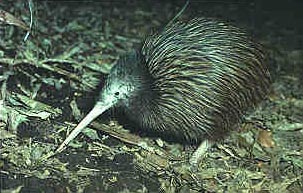

|
Kiwi used to be common in New Zealand - as many as 12 million of them lived all over the country. Maori arrived over a thousand years ago and began hunting kiwi for meat, skin, and feathers. Sometimes the hunters went out with dogs and flaming torches, and at other times they used traps. Maori had several names for kiwi. The
word' kiwi' is a Maori word which copies the sound the kiwi makes
when it calls. Maori used the feathers (and sometimes the skins) to make special cloaks called 'kahu'. The shaft of the feathers (the harder piece in the centre) were sewn into a cloak made of flax. Europeans first saw kiwi early in the 1800's. A ship's captain took a kiwi skin back to England and took it to the British Museum. He gave it a scientific name, described it, and an artist tried to make a picture of it. They published a report which interested a lot of people. Scientists weren't sure at first whether it was a trick or an exciting discovery. |
|
As more and more people came to New Zealand they did many things which harmed the kiwi:
By the end of the century people began to see what was happening to kiwi and in 1896 kiwi were made 'protected' birds. This means that no-one is allowed to kill them. Some were put on special islands , like Kapiti Island off the coast of Wellington. |
 |
 |
|
 |
|